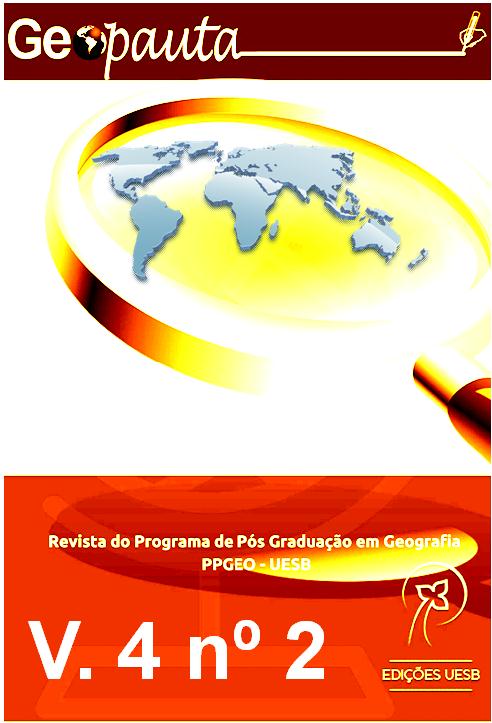Zonificación de riesgo agroclimático de limón (citrus aurantifolia) en la cuenca hidrográfica del río Paraná III, Brasil
DOI:
https://doi.org/10.22481/rg.v4i2.6457Resumen
The lemon tree is one of the most important variety of fruits in Brazil, considered the fifth largest world producer. The purpose of this study was to carry out agroclimatic risk zoning for lemon (Citrus aurantifolia) in the basin of Paraná River III. Technical maps through interpolation and regressions, and graphics for risks analysis probabilities were elaborated. The agroclimatic risk for lemon was established according to the species requirements, such as precipitation, water deficiency, average and maximum air temperature, thermal unit/degrees days and risk of frost. Larger region in the basin is recommended for cultivation of lemon. It was not found inapt areas for cultivation, only restrict, exhibiting considerable potential for cultivation of lemon, in the region of study.
Descargas
Métricas
Citas
CALDANA, N. F. S. et al., Agroclimatic Risk Zoning of Avocado (Persea americana) in the Hydrographic Basin of Paraná River III, Brazil. Agriculture, v. 9, n. 263, p. 1-11, 2019. https://doi.org/10.3390/agriculture9120263
COELHO, Y. da S. et al. A cultura do limão-taiti. Área de Informação da Sede-Col Criar Plantar ABC 500P/500R Saber (INFOTECA-E), 1998.
FAO. 2017. Crops production. Disponível em: http://faostat3.fao.org/download/Q/QC/S Acesso em: 10 jan. 2020.
IPARDES, Instituto Paranaense de Desenvolvimento Econômico e Social. Produção de Limão. Disponível em: < http://www.ipardes.gov.br/imp/index.php > Acesso em: 10 jan. 2020.
LADANIYA, M. S. et al. High density planting studies in acid lime (Citrus aurantifolia Swingle). Scientia Horticulturae, v. 261, p. 108935, 2020. https://doi.org/10.1016/j.scienta.2019.108935
MARCONDES, P. T. S. Manejo do florescimento e da produção de lima ácida Tahiti com reguladores de crescimento e crescimento de derriça. Dissertação (Mestrado em Fruticultura Tropical) – Escola de Agronomia, Universidade Federal da Bahia, Cruz das Almas, 1991.
MATTOS JR., D.; QUAGGIO, J.A.; CANTARELLA, H. Manejo da fertilidade do solo. In: Mattos, JR., D. et al. (Eds.). Lima ácida Tahiti. Campinas: IAC. p.67-80, 2003a.
MATTOS JR., D.; DE NEGRI., D. J.; FIGUEIREDO., J.O. lima ácida Tahiti. Campinas: Instituto Agronômico. Centro Avançado de Pesquisa Tecnológica do Agronegócio de Citros “Sylvio Moreira”, 2003b.
NDO, E. G. D. et al. Tolerance of citrus genotypes towards Pseudocercospora leaf and fruit spot disease in western highlands zone of Cameroon. Crop Protection, v. 124, p. 104828, 2019. https://doi.org/10.1016/j.cropro.2019.05.022
OWI, W. T. et al. Unveiling the physicochemical properties of natural Citrus aurantifolia crosslinked tapioca starch/nanocellulose bionanocomposites. Industrial Crops and Products, v. 139, p. 111548, 2019. https://doi.org/10.1016/j.indcrop.2019.111548
SAM, O.; ROSADO, F.; GONZALEZ, M. E. Crecimiento y desarrollo de frutos de lima Persa (Citrus latifolia Tan) durante dos años en las condiciones del sureste de la Habana. Universidad Central de las Villas, Santa Clara (Cuba)., 1988. sidalc.net/cgi-bin/wxis.exe/?IsisScript=CENIDA.xis&method=post&formato=2&cantidad=1&expresion=mfn=044812 Acessed in 22, sep, 2019.
SANTOS FILHO, H. P. Citros: o produtor pergunta, a Embrapa responde. Área de Informação da Sede-Col Criar Plantar ABC 500P/500R Saber (INFOTECA-E), 2005. https://www.infoteca.cnptia.embrapa.br/infoteca/handle/doc/119224 Acessed in 11, nov, 2019.
SILVA, C. R. et al. Water relations and photosynthesis as criteria for adequate irrigation management in ‘Tahiti’ lime trees. Scientia Agricola, v. 62, p. 415-422, 2005. http://dx.doi.org/10.1590/S0103-90162005000500001
VOLPE, C. A. et al. Citros. in. MONTEIRO, J. E. B A. Agrometeorologia dos cultivos: o fator meteorológico na produção agrícola. Brasília: INMET, p. 321-332, 2009. http://www.inmet.gov.br/portal/index.php?r=home/page&page=livro_agro Acessed in 30, sep, 2019.
STUCHI, E.S.; CYRILLO, F.L.L. Lima ácida “Tahiti”. Funep, 1998.
Descargas
Publicado
Cómo citar
Número
Sección
Licencia
Derechos de autor 2020 De la Revista Geopauta y de lo(s) Autor(es)

Esta obra está bajo una licencia internacional Creative Commons Atribución 4.0.
Derechos de autor
Los autores conservan de forma irrestricta los derechos de autor y otorgan a Geopauta la primera publicación con el trabajo licenciado simultáneamente bajo (CC BY.), lo que permite a otros compartir con reconocimiento de autoría de cada autor en la publicación inicial en esta revista.
Propiedad intelectual y condiciones de uso
Geopauta adopta la política de Acceso Libre de acuerdo con el Acceso Abierto - OAC recomendado por el DOAJ y de acuerdo con los Criterios SciELO, bajo una Licencia Internacional Creative Commons CC By Attribution 4.0, permitiendo el acceso gratuito inmediato a la obra y permitiendo a cualquier usuario leerla. descargar, copiar, distribuir, imprimir, buscar o vincular los textos completos de los artículos, rastrearlos para indexarlos, pasarlos como datos al software o utilizarlos para cualquier otro propósito legal.
Geopauta atribuye la licencia CC BY. donde está permitido sin restricciones:
Compartir: copiar y redistribuir el material en cualquier medio o formato para cualquier fin, incluso comercial. siempre y cuando den el debido crédito a la creación original.
Adaptar: remezclar, transformar y crear a partir del material para cualquier propósito, incluso comercial, siempre y cuando se dé el debido crédito a la creación original.












